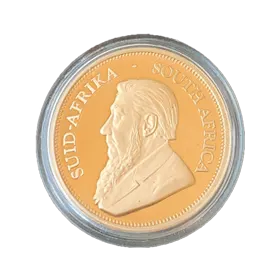
1967 Proof Krugerrand
1967 marked the first year of Krugerrand production, introducing both Bullion and Proof gold coins. The decision to produce Proof versions alongside Bullion coins helped establish the Krugerrand's reputation as a globally recognized gold coin.
Most sources emphasize Bullion Krugerrands, but this site is dedicated to the distinct features of Proof Krugerrands.
Today, distinguishing a Proof Krugerrand from a Bullion Krugerrand is straightforward. Proof Krugerrands typically feature fine reeding, frosted lettering and images, and mirror-finished fields. However, this was not always the case, especially in 1967. Early Proof Krugerrands from 1967 featured the same coarse reeding as Bullion Krugerrands, with their distinguishing mirror-finish limited to the fields. As a result, a polished Bullion Krugerrand from that year could easily resemble a Proof version.
Proof Krugerrand 1967 Value
A 1967 Proof Krugerrand with a Grade of PF65 was auctioned in December 2018 and was sold for $1,500 while the gold price was $1,270, reflecting a 20% premium over the gold price at that time.
| 1967 | Information |
|---|---|
| Hern's Number | K1 |
| Krause-Mishler Number | KM73 |
| Designer | CLS Coert Steynberg |
| Diameter | 32.61 to 32.77 mm |
| Thickness | 2.87 to 2.97 mm |
| Mintage (Proof) | 10,000 |
| Mintage (UNC/Bullion) | 50,000 |
| Total Weight | 33.9305 g |
| Gold Weight | 31.1 g (1 oz) |
| Gold Content | 91.667% |
| Copper Content | 8.33% |
| Reeding | Coarse |
| Certificate of Origin | No |
| Frosted Features | No |
| Best Known Grade | PR68 |